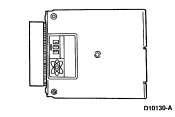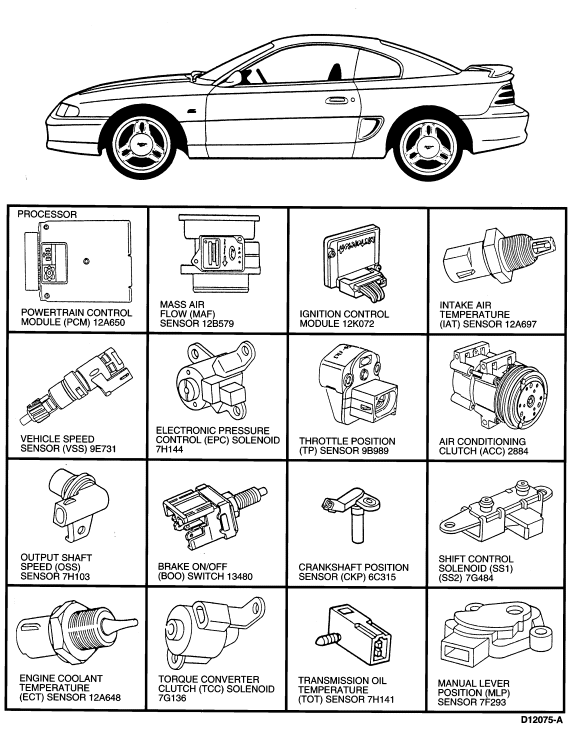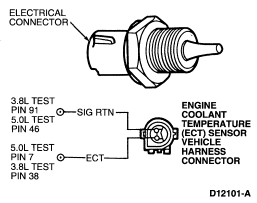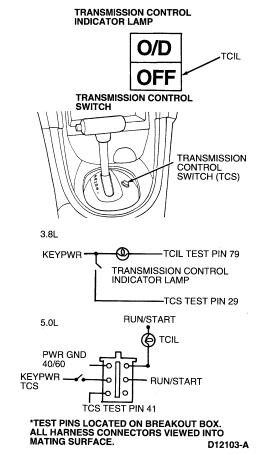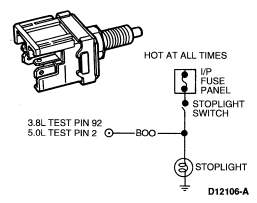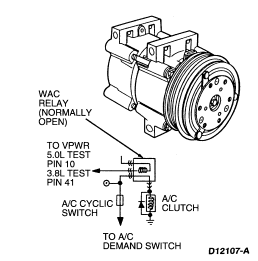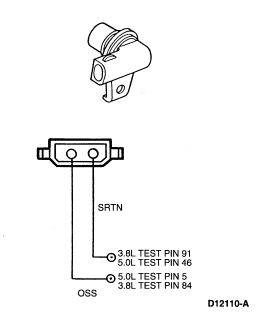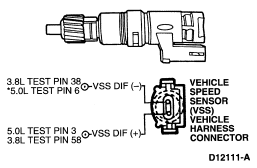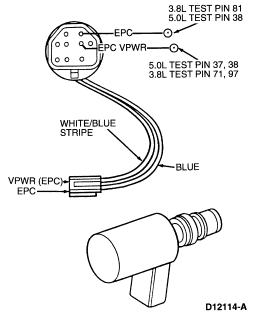Transmission Oil Temperature (TOT) Sensor 7H141:
|
| The transmission oil temperature sensor is located on the transmission main control valve body
. It is a temperature sensitive device called a thermistor. The
resistance value of the TOT will vary with temperature change. The powertrain control module monitors the voltage across the TOT to determine the temperature of the
transmission oil. |
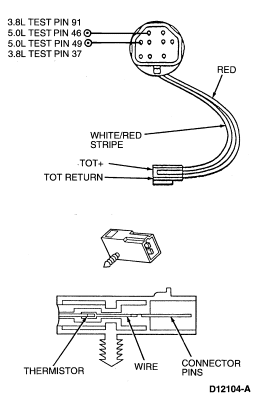 |
| Transmission Function:
The powertrain control module uses this voltage signal to determine whether a cold start shift
schedule is necessary. The shift schedule is compensated when the transmission
fluid temperature is cold. The powertrain control module also inhibits torque converter clutch operation at low transmission
fluid temperatures and corrects EPC pressures for temperature. |
| Symptoms:
Converter clutch engagement and stabilized
shift schedules happen too soon after a cold start. |
| 5.0L DTCs:
636, 637, 638, 657 |
| 3.8L DTCs:
P0712, P0713, P1711, P1783 |
Manual Lever Position (MLP) Sensor 7F293:
|
The powertrain control module sends a voltage signal to the manual lever position sensor (MLP). The
MLP incorporates a series of step-down resistors which act as a voltage
divider. The powertrain control module monitors this voltage which corresponds to the position of the manual
lever (P, R, N, D, 2, 1). The MLP is located on the outside of the transmission
at the manual control lever.
NOTE:
The sensor also contains the park/neutral position and
backup lamp circuits. |
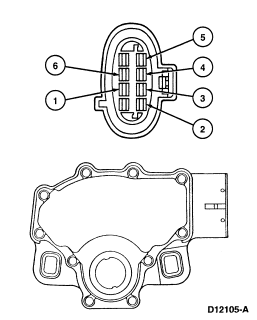
- 359 GY/R PCM Signal Return
- 33 W/PK Start
- 140 BK/PK Back-Up Lamps
- 298 P/O Accessory Feed
- 32 R/LB Start
- 199 LB/Y Sensor Signal to PCM
|
| Transmission Function:
Determines desired gear and
EPC pressure. |
| Symptoms:
Engagement concerns, wrong gear, no shifts. |
| 5.0L DTCs:
522, 634 |
| 3.8L DTCs:
P0707, P0708, P1705, P1706, P1709 |
Electronic Ignition (EI) System:
|
| The electronic ignition system consists of a crankshaft position sensor, ignition control module, two four tower ignition coils and the powertrain control module. The ignition control module operates by sending crankshaft position information from the crankshaft position sensor to the ignition control module. The module generates a PIP signal
(engine rpm) and sends it to the powertrain control module. |
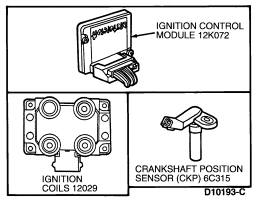 |
| Transmission Function:
Uses rpm signal in the
transmission strategy. Wide-open throttle (WOT) shift control, torque converter
clutch control and EPC. |
| Symptoms:
Harsh engagements and shifts, late WOT
shift, no torque converter clutch engagement. |
| 5.0L DTCs:
211, 212, 214 through 217, 232, 238 and 241 |
| 3.8L DTCs:
P0300 through P0308, P0320, P0340, P1351
through P1364 |
Mass Air Flow (MAF) Sensor 12B579:
|
| The mass airflow sensor directly measures the mass of air
flowing into the engine. The sensor output is a DC
(analog) signal ranging from 0.5 volt to 5 volts used by the powertrain control module to calculate injector pulse width. For transmission strategies, the mass airflow sensor
is used for EPC pressure control, shift and torque converter clutch
scheduling. |
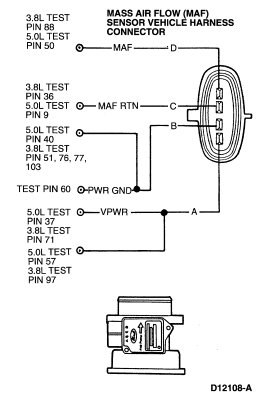 |
| Transmission Function:
EPC pressure control, shift
and torque converter clutch scheduling. |
| Symptoms:
High/low EPC pressure, incorrect shift
schedule, incorrect converter engagement scheduling and symptoms similar to a throttle position sensor
malfunction. |
| 5.0L DTCs:
157, 158, 159, 184 and 185 |
| 3.8L DTCs:
P0102, P0103, P1100, P1101 |
Throttle Position (TP) Sensor 9B989:
|
| The throttle position sensor is a potentiometer mounted on the throttle body. The throttle position sensor detects the position of the throttle plate and sends this information
to the powertrain control module as a varying voltage signal. |
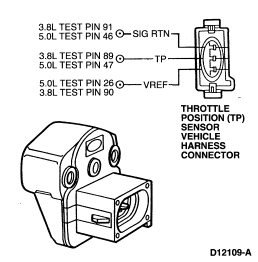 |
| Transmission Function:
Shift scheduling, EPC pressure
control, torque converter clutch control. |
| Symptoms:
Harsh engagements, firm shift feel,
abnormal shift schedule, torque converter clutch does not engage, torque
converter
clutch cycling. |
| 5.0L DTCs:
121, 122, 123, 124, 125, 167 |
| 3.8L DTCs:
P0122, P0123, P1120, P1121, P1124, P1125 |
Shift Solenoid Assembly, Shift Control Solendoids 1 and 2 (7G484)
|
| Two ON/OFF shift solenoids
are used for electronic shift scheduling.
One unit containing the two solenoids is located in the main control assembly.
The solenoids are two-way, normally open style. |
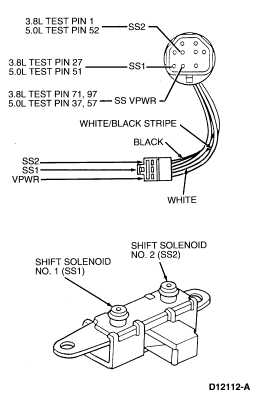 |
| Transmission Function:
Solenoids SS-1 and SS-2
provide gear selection of first through fourth gears by controlling the
pressure to the three shift valves. |
SS1 Symptoms:
Improper gear selection depending on
failure mode and manual lever position.
- Failed "ON"—first and fourth gear only.
- Failed "OFF"—second and third gear only.
|
| 5.0L DTCs:
617**, 618**, 619**, 621* |
| 3.8L DTCs:
P0750*, P0751**, P1731**, P1732**, P1733**,
P1751 |
SS2 Symptoms:
Improper gear selection depending on
failure mode and manual lever position.
- Failed "ON"—third and fourth gear only.
- Failed "OFF"—first and second gear only.
|
| 5.0L DTCs:
618**, 619**, 622* |
| 3.8L DTCs:
P0755*, P0756**, P1732**, P1733**, P1756 |
SS1 and SS2 Symptoms:
- Both failed "ON"—fourth gear only.
- Both failed "OFF"—second gear only.
|
| 5.0L DTCs:
621*, 622* |
| 3.8L DTCs:
P0750*, P0751, P0755*, P0756 |
| * Output circuit check, generated only by electrical conditions. |
| ** May also be generated by some non-electrical transmission
component condition. |
Torque Converter Clutch (TCC) Solenoid 7G136:
|
| The torque converter clutch solenoid is used to control the apply and
release of
the torque converter clutch. |
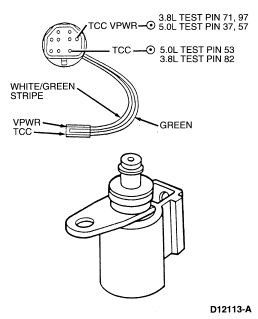 |
| Transmission Function:
Used to engage the torque
converter clutch. |
Symptoms:
- Failed "ON"—engine stalls in second gear (D, 2 range) at low idle speeds with the brake applied.
- Failed "OFF"—torque converter never engages.
|
| 5.0L DTCs:
628**, 652*, 656** |
| 3.8L DTCs:
P0741**, P0743*, P1741**, P1742, P1743 |
| * Output circuit check, generated only by electrical conditions. |
| ** May also be generated by some non-electrical transmission
component condition. |
